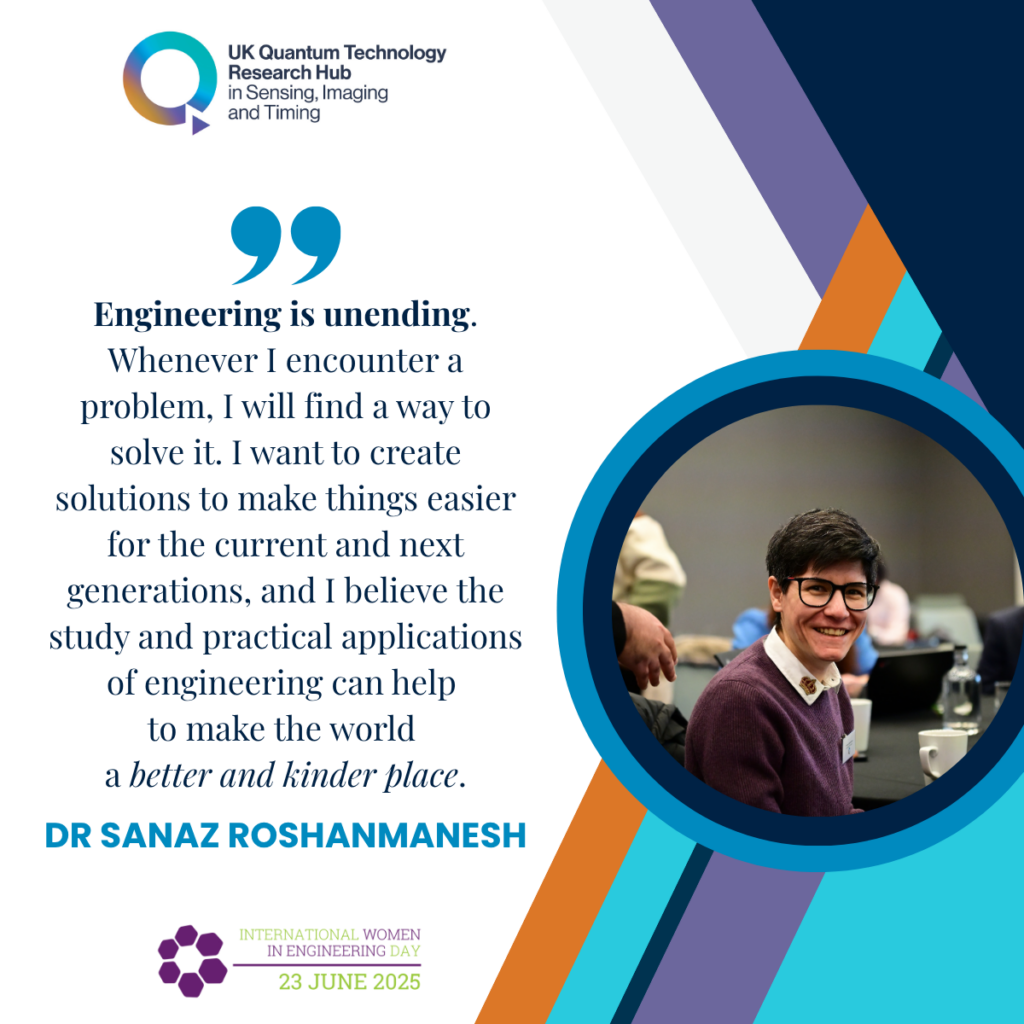To mark International Women in Engineering Day 2025, we have collected stories from a few of our female QuSIT Hub researchers to showcase their brilliant contributions to engineering research and technology.

I grew up in the 1980s when the electricity was not always available. During this time, I used to build small circuits using batteries and miniature lamps from the age of five to help during electricity outages. We were struggling with the lack of electricity at the time, and I thought to myself – what can I do to make life easier for my family?
Most of my family have been lawyers and doctors, and my father is an engineer. Similarly to my father, I have always tended to see the world through an engineering lens. When I went to school, I used to read and write about scientists and inventors such as Einstein, and I thought about ways we could make things better for each other, and for future generations.
While I was going to school, I went to several supplementary schools, exploring my love of music and sports, but I received a lot of encouragement from my family and teachers to pursue engineering, which remained my main focus throughout the years.
After studying maths and statistics at the University of Tehran, I travelled to various countries before returning to pursue a master’s degree in electrical engineering and communication with the University of Birmingham, so I soon travelled to Birmingham in the UK. After completing this programme, I studied for an MSc in satellite and mobile communications, as well as an MRes in RF and microwave engineering, being the only female who had ever taken this course. My PhD research was also in the field of engineering, and I explored non-destructive testing and condition monitoring for industrial machineries.
It was at this time that I started assisting with field trials in the Quantum Technology Hub, specifically with compact systems as there was a need for RF engineers. I worked with spinout company Aquark to build miniature sensor technology, and in 2022, I was one of the co-authors on a paper announcing the gravity gradiometer sensor breakthrough, where an object hidden below ground was located using quantum technology – a long-awaited milestone, and a world first.
Engineering is unending. When I encounter a problem, I will find a way to solve it. I always remind myself that as an engineer I will be able to either find a way or make a way to solve my problem. I want to create solutions to make things easier for the current and next generations, and I believe the study and practical applications of engineering can help to make the world a better and kinder place.

I have always been fascinated by light, how something so familiar can also be incredibly complex and full of hidden layers. As a child, I was drawn to tools like microscopes and lasers because they allowed me to explore things that are normally invisible to the naked eye. This early curiosity inspired me to study how light behaves at very small scales, where quantum effects begin to emerge.
During my PhD, I focused on designing integrated devices such as multifunctional crystal waveguides and nanostructures that can guide and control light in powerful ways. Later, I researched how to generate entangled photons using semiconductor quantum dots, technology that could one day underpin future quantum systems. These experiences gave me a strong foundation in both materials’ science and quantum optics.
Now, at the University of Bristol, and as a UK Quantum Technology Research Hub in Sensing, Imaging and Timing researcher, I am dedicated to developing compact and scalable quantum photonic devices by combining nonlinear crystals, photonic integration, quantum light sources, and nanostructures. What excites me most is transforming these ideas into real, working technologies that can make a difference beyond the lab. Engineering gives me the opportunity to bring these innovations to life, and I am excited by the potential of integrated quantum photonics to revolutionise computing, communication, and sensing, opening new frontiers in technology and science.

I was drawn to science and engineering from a really young age, ever since primary school, when I realized it was all about shaping the future, not just understanding the past. My early love for building toys, for creating and problem-solving, definitely set me on this path. While my background is in physics, I’ve always been hooked on applied physics – using scientific principles to tackle real-world challenges.
My career journey has been a bit unconventional; being neurodivergent means I’ve often bounced between research areas. But that’s actually been a strength, allowing me to dive deep into fascinating problems at the boundaries of different disciplines, always focused on measurement, sensing, and imaging.
Right now, I’m incredibly excited about diamond-based quantum sensors. They offer amazing precision and resilience, opening up possibilities for fields like quantum biology, where we could unlock nature’s secrets for more efficient energy, self-healing materials, or new therapies.
Looking ahead, I see one of my most important roles will be to help nurture the next generation of scientists and engineers, encouraging them to embrace their creativity, unique perspectives, and inner child.

